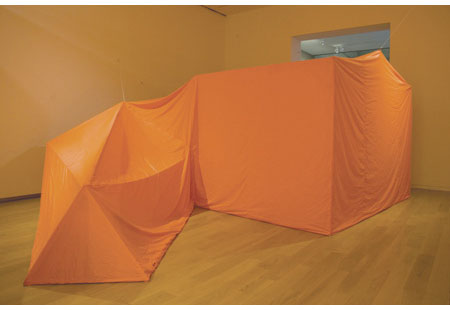
In the brochure accompanying "FOCUS: Gabriel Acevedo Velarde," Andrea Karnes astutely points out "the idea of 'relational aesthetics' is key in Acevedo Velarde's work." The title of French curator Nicolas Bourriaud's 1998 publication, "Relational Aesthetics" refers to works of art that prioritize social interaction between people in the gallery space over the form of the art. Social meaning is more important than artistic appearance.
In Acevedo Velarde's work, relational aesthetics registers in its most compelling and persuasive manner by way of physical, bodily engagement. This is most powerfully felt in Music Cone Tents, a two-room tent made from orange fluorescent polyester material used by the homeless people in the artistÕs native home of Peru. The space encloses two viewing areas for the artistÕs sociological takes on music captured in video. One tent room finds a low-slung ceiling pushing viewers onto two floor mats to watch a video of Acevedo Velarde interviewing his parents in Peru. Their discussions about the 1970s Peruvian Left are intercut with Acevedo Velarde's conceptual diagrams and ruminations about his past anti-American elitism, which made him blind to the power of pop music. One tent room over, you find the artist interviewing Peruvians on the street about their musical tastes, the point being that preferences for certain genres are socio-economically driven. Relational aesthetics succeed here in the way in which the tent enclosure forces the body of the viewer to the floor to watch and listen to the artist's video about his parents, leftist politics and music. There, she lolls around on the floor, plays footsy with fellow museum-goers, or even takes a nap. The two other works that make up the entirety of the show, Runway Blanket and Landscape, also center visually around the orange fabric of homeless shelters in Peru.
The problem with relational aesthetics in this instance is that it is a pallid stand-in for actual political engagement. Seeing the show, learning about homelessness in the form of orange fluorescent polyester, serves as penance for the secular museum-goer. It allows her to live comfortably with "knowing about it" as a form of political action.
